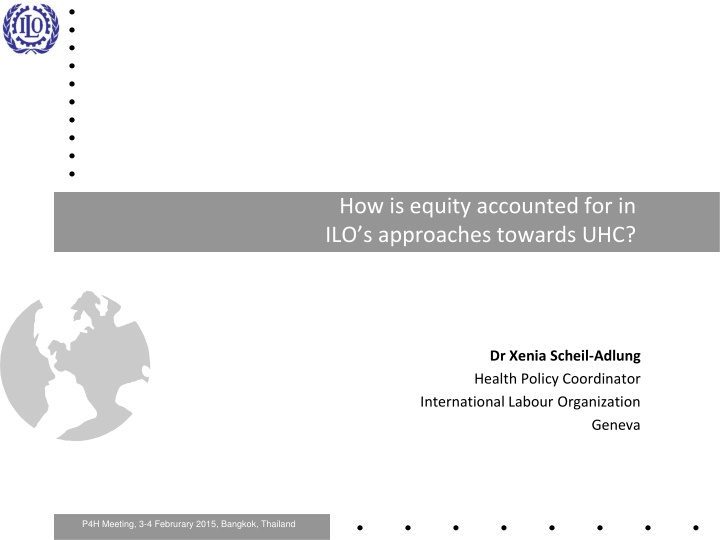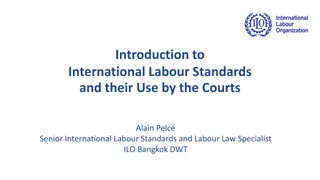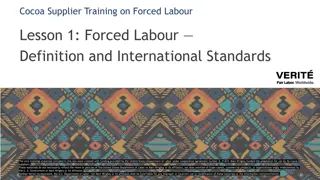
Equity Considerations in ILO's Approach to Universal Health Coverage
Dr. Xenia Scheil-Adlung, Health Policy Coordinator at the International Labour Organization, discussed how equity is integrated into ILO's strategies for achieving Universal Health Coverage (UHC). The focus was on addressing disparities through national social protection floor policies, legal coverage based on poverty rates, and the importance of ensuring a sufficient number of skilled health workers. Disparities in urban and rural areas, geographical inequities in legal coverage, and staff access deficits were highlighted as key challenges in achieving equity in healthcare provision.
Download Presentation

Please find below an Image/Link to download the presentation.
The content on the website is provided AS IS for your information and personal use only. It may not be sold, licensed, or shared on other websites without obtaining consent from the author. If you encounter any issues during the download, it is possible that the publisher has removed the file from their server.
You are allowed to download the files provided on this website for personal or commercial use, subject to the condition that they are used lawfully. All files are the property of their respective owners.
The content on the website is provided AS IS for your information and personal use only. It may not be sold, licensed, or shared on other websites without obtaining consent from the author.
E N D
Presentation Transcript
How is equity accounted for in ILO s approaches towards UHC? Dr Xenia Scheil-Adlung Health Policy Coordinator International Labour Organization Geneva P4H Meeting, 3-4 Februrary 2015, Bangkok, Thailand
Overview Addressing inequities through national social protection floor policies What are the issues behind inequities? Equity and universality P4H Meeting, 3-4 Februrary 2015, Bangkok, Thailand
Equity requires rights resulting in affiliation to a scheme or system : Legal coverage by poverty rate ILO, 2014 P4H Meeting, 3-4 Februrary 2015, Bangkok, Thailand
Equity requires a sufficient number of skilled health workers ensuring quality (ILO threshold 41.1 health workers per 10,000 population in 2014) Deficit Africa: 2.8 million Global deficit: Deficit Oceania: Deficit Asia: 10.3 million health sector jobs Deficit Europe: 27 thousand 7.1 million Deficit Latin America: 391 4.3 thousand thousand P4H Meeting, 3-4 Februrary 2015, Bangkok, Thailand
Adequate benefits must be available in all urban and rural areas Differences in rural/urban distribution of health workers and resulting population coverage gaps towards UHC Geographical inequities in legal coverage between rural and urban areas (ILO 2015) Top 10 Top 10 Bottom 10 countries with highest SAD Bottom 10 countries with highest rural/urban differences in SAD 44 World countries with lowest rural/urban SAD (excluding countries with zero deficit) countries with lowest rural/urban differences in SAD (excluding countries with zero deficit) 78 100 Western Europe 100 Central and Eastern Europe 86 98 82 North America 86 Guatemala China Somalia Timor-Leste Latin America & the Caribbean 67 Turkey Costa Rica Guinea Nigeria 90 Dom. Republic Thailand Niger Bolivia 59 Middle East 81 China Dominican Rep. Chad Lao s Asia and the Pacific (excl China and 40 Namibia Jamaica Ethiopia Peru 81 Belize Guyana Liberia Morocco Asia and the Pacific (inc China & India) 44 76 Vietnam Belize Haiti Yemen 17 Africa Colombia Vietnam Burundi Turkey 39 Costa Rica Nicaragua Cen. Af. Rep. Zambia 0 20 40 60 80 100 Thailand Colombia Tanzania Kenya % of population affiliated to national health service or insurance scheme Rural Urban Staff access deficit (SAD): Per cent of the population without access to health care due to the absence of the health workforce (Threshold: 41.1 health workers per 10,000 population) P4H Meeting, 3-4 Februrary 2015, Bangkok, Thailand
Equity requires affordability and financial protection Out-of-pocket payments by country level of poverty Latest available year ILO, 2014 P4H Meeting, 3-4 Februrary 2015, Bangkok, Thailand
for everybody and everywhere Age-related inequities Income effects of OOP among the 50+ (ILO 2006) 6 OOP as a share of household 5 4 income 3 2 1 0 prescibed medicines inpatient outpatient P4H Meeting, 3-4 Februrary 2015, Bangkok, Thailand
Equity requires a sufficient scope of benefits Percentage of elderly households paying more than 100 % of income on health expenditure, in selected European countries with universal coverage, 2004 2.5 2 1.5 1 0.5 0 ILO 2013 P4H Meeting, 3-4 Februrary 2015, Bangkok, Thailand
Where are we with equity at global level? Rights / Legislation Estimate of health coverage deficit as % of total population Quality Availability 90.3 Coverage gap due to health professional staff deficit (relative benchmark: median value in low vulnerability group of countries: 41.1 per 10,000 population) Maternal mortality ratio (modelled estimate, per 10,000 live births) 82.5 37.5 47.8 Financial Protection Financial deficit: per capita health spending (except OOP) (relative benchmark: median in low vulnerability group of countries: 239 US$) Affordability OOP expenditure as % of total health expenditure 92.6 Low-income economies High-income economies Source: Universal Health Protection: Progress to date and the way forward. International Labour Office, Social Protection Department. Geneva: ILO, 2014. P4H Meeting, 3-4 Februrary 2015, Bangkok, Thailand
Addressing inequities through national social protection floor policies Equity and universality What are the issues behind inequities? P4H Meeting, 3-4 Februrary 2015, Bangkok, Thailand
Systemic issues resulting in inequities in access to health care Availability Financing and resource generation Affordability Socio-economic factors Policy of services and benefits coordination of care Gaps in financial protection e.g. OOP, transport costs Gaps in benefit packages Absence of coordinated policy approaches for health and other social and economic sectors e.g. labour market and social security Under- funding Deficits in poverty alleviation and income support Gaps in burden sharing and risk pooling Inequities due to gender, age, migration, ethnics Lack of health infrastructure and health workers Labour market policies facilitating job creation and transition from informal to formal labour markets Issues within the health sector Issues beyond the health sector P4H Meeting, 3-4 Februrary 2015, Bangkok, Thailand
Global impacts on equity in access to health care Global and national policies used to address the past financial and economic crises Current financial policies, exchange rate developments, threats of depts in EU countries including Grexit and petrol prices impacting on global and national economic growth (EU, China, LA, USA) Geopolitical crises result in inequities due to Changes in employment status and informalization of work Income reductions Increased expenditure (food, housing, health care) Household level Budget cuts on social (health) protection programs, e.g. reductions in benefit packages, increased co-payments, wage bill cuts of health workers Increase in overall poverty and unemployment Budget cuts on social protection programs e.g. for the chronically poor National level P4H Meeting, 3-4 Februrary 2015, Bangkok, Thailand
Addressing inequities through national social protection floor policies Equity and universality What are the issues behind inequities? P4H Meeting, 3-4 Februrary 2015, Bangkok, Thailand
Achieving equity through national social protection floors ILO Recommendation 202: Proving for basic guarantees to prevent and alleviate ill health, poverty, unemployment and other vulnerabilities through health and income support Ensuring coverage in health protection Addressing gaps in coverage and access to income support Income security at poverty level for those in old age, invalidity and survivors securing access to needed services Income security at poverty level for all children to access education, health, housing Social assistance for the poor and unemployed in working age Universal access to preventive and curative health care groups Everyone should have - The right to be affiliated to a health scheme or system - Guaranteedaccess to at least essential quality health care that is available, affordable and financially protected P4H Meeting, 3-4 Februrary 2015, Bangkok, Thailand
Components, principles and criteria of equitable access to health care in the context of national social protection floors ILO Recommendation 202 on National Social Protection Floors) Universal access to nationally defined, at least essential benefits including preventive and maternal care for all citizens and children; Health protection Consist of an in-kind and in-cash component Rights-based; Universal; Equitable; Solidarity in financing; Affordable; Available; Of sufficient quality; Financially protected Are based on key principles and criteria P4H Meeting, 3-4 Februrary 2015, Bangkok, Thailand
ILOs comprehensive approach to address access inequities within National Social Protection Floor Policies 1. Ensuring coverage and access to health protection Inclusive legislation Health protection Fair financing Extending coverage through inclusive rights-based approaches, non-discrimination and equity re informal economy workers, rural areas, ethnicities, etc. Financial protection of at least essential quality benefits that are available and affordable for all Fair burden sharing and solidarity in financing using taxes, contributions and minimizing OOP 2. Addressing poverty and ensuring access to income Universal social protection Labour market policies Other policies Focus on income support, poverty prevention and alleviation Ensuring income generation from formal work enabling tax/contribution payments for health Ensuring policy coordination and coherence of developmental, economic, social and health polices to achieve poverty alleviation and UHC Setting priorities on national consultation Support disadvantaged groups and people with special needs P4H Meeting, 3-4 Februrary 2015, Bangkok, Thailand
Summary 1. Root causes of inequities relate to Gaps in legislation, design and financing of health protection Social and economic policies and status of the vulnerable 2. Addressing these issues in the context of social protection floor policies can be achieved by: Extending coverage and effective access in social health protection Increasing legal coverage through coordinated social protection schemes, extending risk pooling and ensuring equitable access Making prevention and curative care affordable and available Addressing social and economic determinants of inequities in access: Providing an essential level of cash and in kind benefits Increasing (formal) labour market participation of the vulnerable Reducing poverty and social exclusion Developing coherent social, economic and labour market policies Increasing policy coherence P4H Meeting, 3-4 Februrary 2015, Bangkok, Thailand
Thank you ! scheil@ilo.org P4H Meeting, 3-4 Februrary 2015, Bangkok, Thailand






















